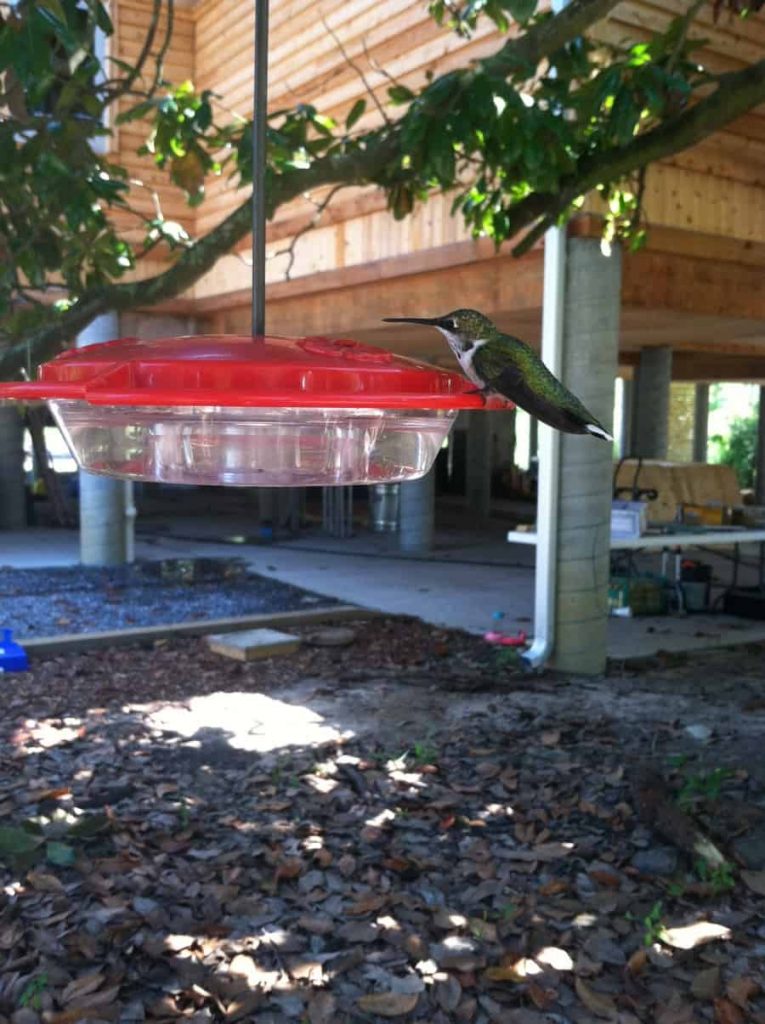[et_pb_section admin_label=”section”][et_pb_row admin_label=”row”][et_pb_column type=”4_4″][et_pb_text admin_label=”Text”]
March 15, also known as the Ides of March, doesn’t have a sinister connotation in Jackson County. It’s the day that marks the annual return of our summer residents, the Ruby-Throated Hummingbirds.

These fast-moving nectar-drinkers return from their winter habitat in Central and South America in mid-March each year just as the first flowers appear on our native cross vine and coral honeysuckles.
Hummingbirds spend the summer in Jackson County, seeking out nectar from flowers and feeders. During their nesting season (June-August) they will spend more time seeking out insects, particularly caterpillars, to feed their young and you may see less of them during this time.
The best way to attract hummingbirds to your backyard is to provide them with plenty of nectar sources. A combination of native plants, a few special tropical blooms, and nectar feeders will help keep your hummingbird visitors happy and healthy.
Here are some tips and tricks to attract hummingbirds to your yard:
Nectar Feeders
Simple nectar feeders can be filled with a mixture of water and white table sugar, in a 4 parts water to 1 part sugar ratio. Do not fill your feeders completely full, as the sugar water tends to ferment quickly in our hot climate. Add a small amount to your feeders and keep the rest in your refrigerator to slow spoilage.
Feeders will need to be cleaned regularly (at least weekly) during the warmest months as the sugar water attracts ants, bees, and can quickly grow mold. Scrub the parts (inside and outside) with hot soapy water and a dash of vinegar, rinse well, and refill. You’ll often find your resident birds impatiently awaiting the return of their favorite feeder!
It is NOT recommended that red food coloring be added to the nectar solution, and some evidence indicates that red dyes may be harmful to hummingbirds.
Native Plants
Planting native plants with tube or trumpet shaped flowers encourages hummingbirds and other winged pollinators to your garden. Crossvine (Bignonia capreolata), trumpet creeper (Campsis radicans), coral honeysuckle (Lonicera sempervirens), and various salvia species provide plenty of nectar.
Native plants are adapted to our Coastal climate, are typically more tolerant of our native insect pests, and provide habitat and food for a variety of wildlife. Native plants generally require less from gardeners (except maybe some pruning when they overgrow their space) than plants adapted to other weather and climate regimes.
Tropical Plants
There are some wonderful tropical plants that can be added to encourage hummingbirds as well. The bottlebrush tree (Callistemon citrinus) is a familiar sight, though it is actually native to Australia, and its beautiful red flowers bloom just as the hummingbirds return to Jackson County, making it a great addition to a bird-friendly backyard. Many tropical plants can be grown as annuals here along the Coast as they cannot survive even our mildest winters and are welcome garden guests during the summer. Fuschias (Fuschia magellanica), cosmos (Cosmos bipinnatus), and other bright and cheerful flowers can keep hummingbirds well fed and gardeners happy.
[/et_pb_text][/et_pb_column][/et_pb_row][/et_pb_section]




